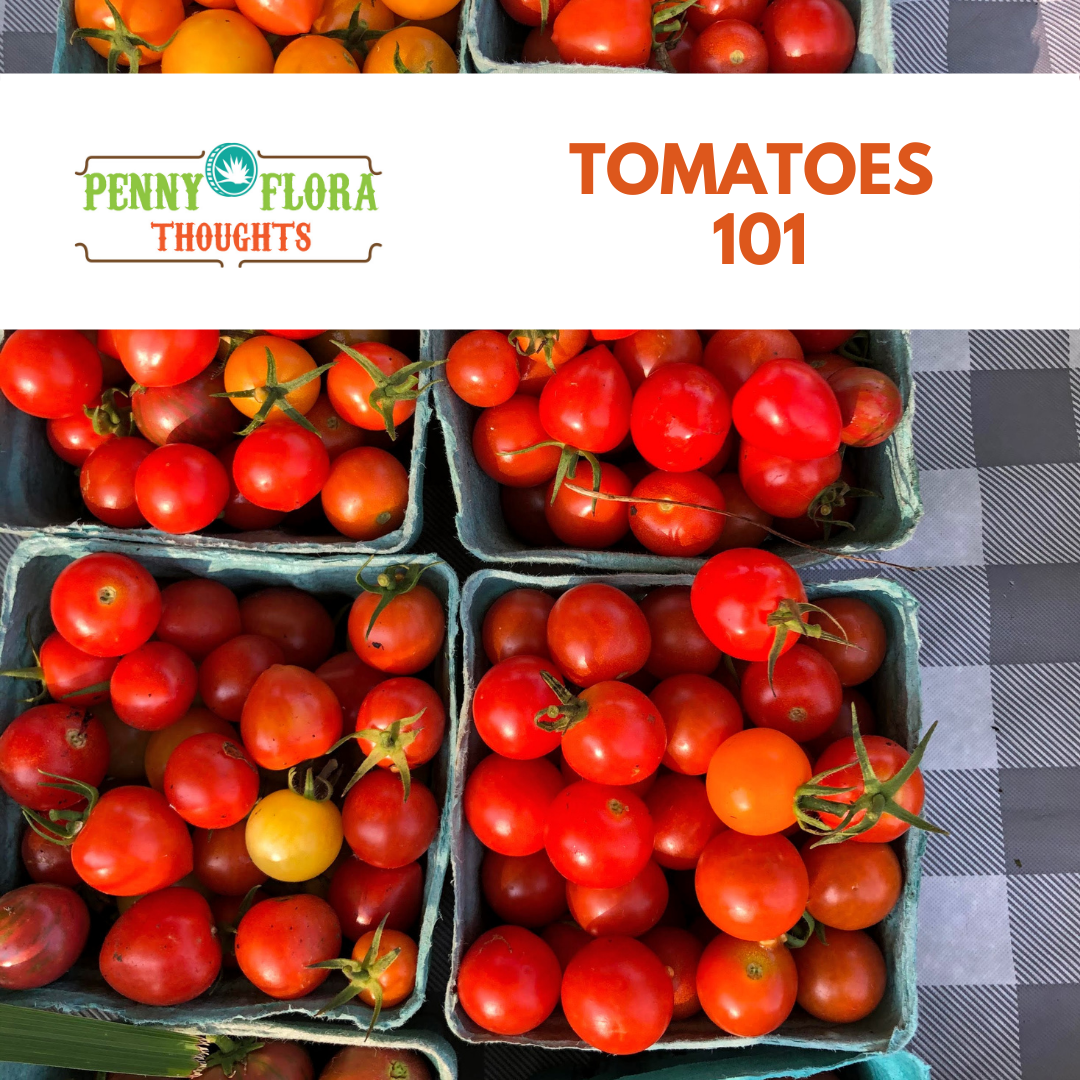It’s almost tomato season – oh, yea! Customers are anticipating the first picks and oh-so-heavenly bites of this garden fruit we use as a vegetable. Our team at Groovy Plants Ranch is ready for all your tomato growing questions and has put together this guide of tips and curated links to make this tomato season your best ever.
History

Did you know the first tomatoes originated in Central and South America, were domesticated in Mexico then made their way to the United States in 1700s? Some brag tomatoes are one of only a few native vegetables of the Americas. And, Thomas Jefferson was one of the first to grow tomatoes, then called “love apples.”
Heat Lovers
Tomatoes or Lycopersicon esculentum are considered a heat-loving crop. That means they grow best when soil temperatures reach 65 degrees or more. Here, in Ohio, that typically happens in late May. However, if we wait until then to plant tomato seeds in the ground, the season isn’t really long enough for a big crop of tomatoes to ripen before frost. So, we jump start the season by planting tomato seeds indoors or by starting with nursery-grown transplants to plant in late May. Some eager beavers willfully try planting tomatoes in April and protecting them with insulation, but our experience shows you’ll have more success and avoid things like blossom drop if you wait.
Tomato Lingo
For success in growing tomatoes, it helps to know your tomato’s growth habit – either determinate or indeterminate. Determinate tomatoes grow to a certain height and deliver one crop of tomatoes all at once -- perfect for canning and smaller gardens. On the other hand, indeterminate tomatoes have a more vine-like growth and continue to climb and produce tomatoes all season long. They definitely need staking. Two other tomato terms are heirloom and hybrids. Heirlooms are vintage tomato varieties that pass the same traits from generation to generation. They’re ideal for seed saving. Hybrids are crosses of two tomato parent plants. They’re often more disease resistant but not the best for seed saving since their offspring won’t resemble their parents.
Varieties

The fun part about growing tomatoes is trying all the varieties. There are beefsteak varieties for slicing, Roma varieties for tomato pastes and cherry tomatoes for snacking. For a list of some proven tomato varieties, check out the winners of the All-America Selections. A few of our favorites at Groovy Plants Ranch include San Marzano, Sun Sugar, Black Krim and Better Boy.
Planting

Tomatoes require a sunny location (6-8 hours of sunlight) in a raised bed, garden bed, straw bale or container (minimum 5-gallon size each). To plant, gently pull tomato transplants from their pot and slightly loosen their roots. Remove the lower first two sets of leaves and set the plant in the ground to cover that node where you removed the leaves. Here, new roots will grow and help the plant establish a strong root system. Space plants approximately two feet apart, and check plant tags for more planting specifics. Next, add a tomato cage, garden stake or trellis system to support the plant as it grows. Also, add a layer of straw or mulch to conserve moisture, minimize weeds and prevent diseases caused by soil splashing on the plant.
Maintenance
Tomato plants need consistent water – about 1 to 1 ½ inches of water per week -- to prevent splitting and blossom end rot. It’s best to water in the mornings and water plants at their base. For more watering tips, see this post by Nova Scotia gardener Niki Jabbour. Tomato plants also are heavy feeders and respond well to a dry or liquid balanced fertilizer or one specifically for tomatoes. Generally, fertilize once when planting then every two weeks once the plants set fruit. See the back of the fertilizer package for detailed instructions.
Also, indeterminate tomato varieties can benefit from suckering, a pruning technique of cutting away smaller stems to allow more air circulation and reduce chances for disease. Here are pruning tips from Savvy Gardening and a pruning video from Epic Gardening.
Pests and Diseases
Blight and leaf spot are two common tomato diseases. The best strategy is prevention – rotating crops, choosing disease-resistant varieties, allowing good air circulation, mulching plants, watering consistently, keeping foliage dry and not working in a wet garden, and pinching off diseased leaves and discarding them. Check out the OSU Extension fact sheets for more information on tomato plant diseases.
Insects can also be a concern for tomato gardeners. Begin by examining the pests and noticing the type and amount of damage. If given a chance, many beneficial insects will help keep these pests in check. For example, lady beetles will eat aphids and wasps will lay white eggs on hornworms for the larvae to devour the hornworm alive. If these pests cause too much damage for your tolerance, they can easily be picked off the plant and smashed. Check out this OSU Extension guide to help identify tomato pests and strategies for managing them.
Harvest

Ahhh! It’s the moment you’ve been waiting for – harvesting your tomatoes. The fruits are typically ready to harvest 60-85 days after seedlings are planted outdoors. Monitor closely as harvest time approaches, and watch for even coloring throughout. Tomatoes often ripen from the bottom up, so check the bottom of the tomato first for mature growth color. Also, remember they ripen by heat more than light, so they will ripen even on cloudy days or if picked early. Once the entire tomato has reached its full color, enjoy the harvest and send us pics of your top tomatoes.


1 comment
Do you sell tomatoes for canning?
When will they be ready and what is the price?
Thank you very much
Tina Elsea
614-732-8969